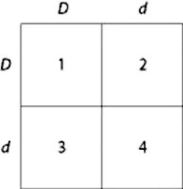Use the figure and the following description to answer the question.
In a particular plant, leaf color is controlled by gene locus D. Plants with at least one allele D have dark green leaves, and plants with the homozygous recessive dd genotype have light green leaves. A true-breeding, dark-leaved plant is crossed with a light-leaved one, and the F1 offspring is allowed to self-pollinate. The predicted outcome of the F1 cross is diagrammed in the Punnett square shown in the figure, where 1, 2, 3, and 4 represent the genotypes corresponding to each box within the square. 
Which of the boxes marked 1-4 correspond to plants with a heterozygous genotype?
Definitions:
Human Behavior
The range of actions and mannerisms exhibited by humans in conjunction with their environment, responding to various stimuli or inputs.
Moral Absolutes
Ethical beliefs that actions are intrinsically right or wrong, irrespective of the context or consequences.
Ethical Relativism
The theory that moral principles are not universal truths but instead vary based on cultural, societal, or personal perspectives.
Ethical Absolutism
The philosophical belief that certain actions are absolutely right or wrong, regardless of context or consequences.
Q9: In the following structure where A and
Q10: Which of the following is one of
Q18: Joe has been asked about one of
Q21: Which of the following statements explains how
Q22: Three living species X, Y, and Z
Q26: Which of the following statements about genetic
Q40: Meiosis II is similar to mitosis in
Q40: The most commonly occurring mutation in people
Q48: Elements 72Zn, 75As, and 74Ge have the
Q56: Which of the following describes the function